Feeding fish can be more complicated than you think. Although tropical fish have been kept by western hobbyists for over a century, our feeding methods have barely changed. Today, there are so many fish foods available on the market, that choosing the right one specific to your tropical fishes is easy. Let’s break it down…
Zebra Angelfish Pterophylum scalare
Origin: South America
Feeding Type: Surface
Freshwater angelfish belong to the Cichlidae family. Their iconic shape and majestic movements have enthralled aquarists for decades. Pterophylum scalare is the most popular species by a long way, but of this species, there are many different varieties. The silver angelfish, zebra angelfish and koi angelfish are arguably the most popular in captivity. They each look unique yet they belong to the same species, P. scalare. Therefore, tropical fish keepers have a lot of choices when it comes to stocking their tanks with this diverse and reasonably easy-to-care-for species.
Angelfish are very hardy. Provided they’re given enough space (some can grow up to 12cm) and are introduced in a small group to help them feel secure, they should live happily in most tropical fish aquariums. They can be a little gregarious and therefore are best housed with much more docile species, such as plecos, mollies and guppies.
As surface feeders, angelfish are best fed floating foods and are perfectly suited to a flake diet. They are omnivorous and will eat a mix of plant matter and invertebrates. This diet will shift over time, particularly as the Amazon basin floods and allows them access to more surface-dwelling insects. Therefore, an omnivorous flake such as the FishScience Tropical Fish Flake Food is perfect for all members of the Pterophylum genus. This should be supplemented with aquatic live foods, or even terrestrial live foods, such as springtails and micro crickets to add enrichment throughout the summer periods.
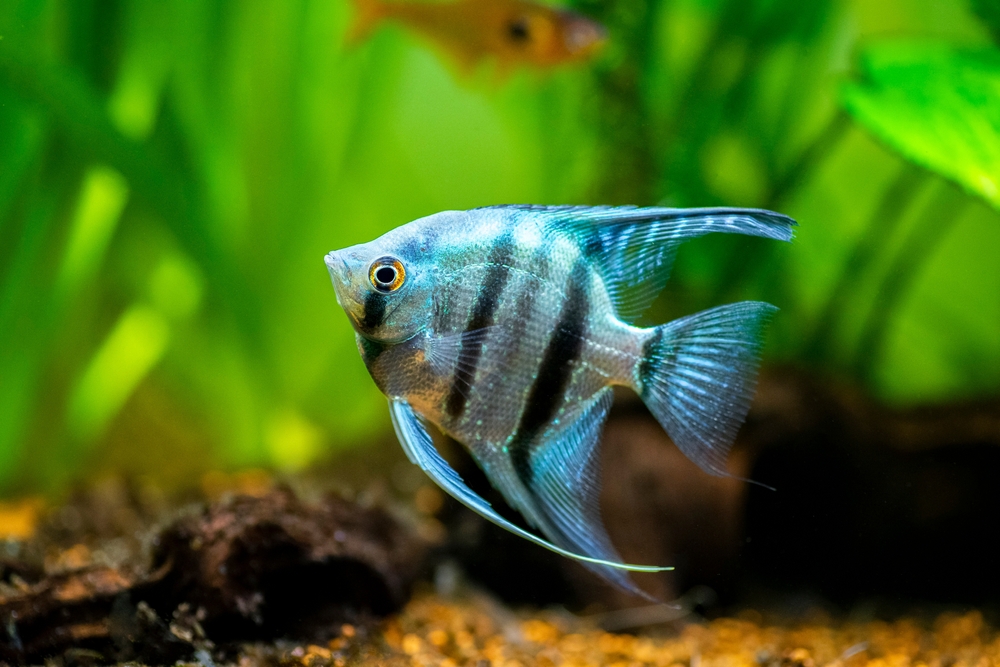
Platies (Xiphophorus sp.) & Mollies (Poecilia sp.)
Origin: South America
Feeder Type: Mixed-Level
Both platies and mollies have been kept in the aquaculture hobby for over 100 years. Originally from Mexico and Central America, these tiny vibrant tropical fish are now available in dozens of varieties. They are both very similar and often difficult to distinguish. Generally, mollies are larger than platies and tend to exhibit a wider range of colours. Part of their popularity for such a long time is that they are excellent community fish and will get on well with just about any tank mate.
They are avid breeders, so keepers may notice some aggression between males or some harassment if the sex ratio is incorrect. Aside from this, they will cohabit peacefully with most smaller, active fish including mollies, danios, plecos and tetra. As they are very active, it’s a good idea to avoid putting them with slow-moving fish that might be intimidated by their quick movements.
Platies are livebearers, which makes breeding them a very interesting project. Although they are omnivores, they do exhibit a preference for vegetation. A specialised vegetable flake is perfect for this species which will happily feed at the surface and tear the flakes apart in an interesting display. Not only are vegetable-heavy diets better suited to these fish, but they also provide a base for keepers to trigger spawning. Simply switch diets to a protein-heavy mix of live food and insect-meal flakes to prompt breeding behaviours. Females can birth up to 80 young after a gestation period of 24-30 days. This should be done in a separate, controlled environment to stop the parents from predating the fry. A sponge should also be applied to the filter of the breeding tank to stop fry from being sucked into it. The fry will also need to be fed a suitably-sized, protein-rich diet to ensure healthy development.

Tetra (Characidae)
Origin: South America
Feeder Type: Mid-Water
There are over 150 different species of tetra fish. These can be found across Latin America and Africa and exhibit huge variations in colour and shape. However, they are generally small, freshwater characiform fishes. Many of them are easy to care for, with docile temperaments and can form impressive-looking shoals. Keepers should research the species in-depth, as some tetras are far more fragile than others.
The most iconic species and long-time aquatic shop staples are the neon tetras. Due to their size, they do not require a particularly large aquarium and will happily live in a paludarium set-up, providing the water is properly maintained with good filtration. Groups should consist of at least eight individuals (though more are recommended for larger setups). They are amongst the most inexpensive of all fish and will readily breed in the most basic of tropical aquariums.
Because of their tiny size, tetra require very small foods. In the wild, they are opportunistic feeders and will consume any tiny invertebrate, larvae, egg or fry that they can fit in their mouths. Therefore, a bitesize insect-based pellet is ideal for them. FishScience Micro Granules are developed to sink slowly into the water, which allows the tetra to feed easily without competition from other fish. This food is also ideal for other smaller characins, danios, guppies and dollars.

Plecostomus (Hypostomus plecostomus)
South America
Bottom-feeder
“Pleco’s” are beautifully patterned, bottom-feeding catfish from South America. They occupy a unique niche in the aquarium and although they are slightly more specialist than most hobbyists assume, they can make an excellent addition to a large tropical tank. Some species can grow up to two feet in length, so hobbyists must understand exactly what species they wish to acquire. There are over 150 varieties of ‘pleco’ but the ‘normal’ form is a species from the Guiana Shield that can grow reasonably large (up to 50cm long in some cases).
Plecos are herbivorous fish that can often be seen feeding on algae build-up across the tank. However, this should not be encouraged as excessive algae can make some species ill. In the wild, they feed on ‘roughage’. This is a mix of driftwood, rotting vegetation and various algae. Although the common bristlenose catfish will feed primarily on algae, this should be supported by commercial fish food. Sourcing a wafer with natural ingredients such as oak or algae is best and allows the fish to feed on them as they slowly dissolve.
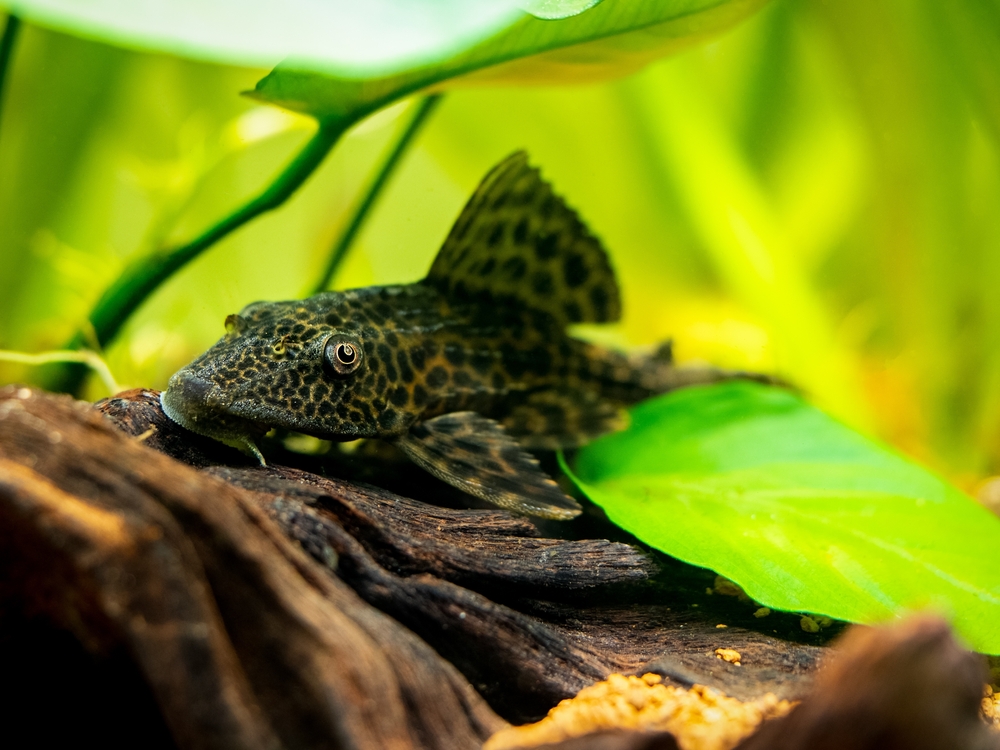
Siamese fighting fish (Betta splendens)
Origin: Southeast Asia
Feeder Type: Surface
Siamese fighting fish are arguably the most beautiful tropical fish that a person can keep. Belonging to the genus Betta, they are part of a group of over 70 different species which are often considered synonymous with the term ‘fighting fish’. Most Betta’s are vibrantly coloured with ornamental fins and move majestically through the water. Although they have been kept for over 150 years and are often presented as a ‘beginner’ fish, Betta vary in their hardiness and behaviour.
Betta splendens is a territorial fish – hence the common name. They are a common fish in Southeast Asia and can be found in shallow water, including rice paddies. Hundreds of years ago, Thai (formerly Siamese) children noticed that male Bettas would fiercely defend their territories. They placed fish together and watched them fight and unknowingly created an entire betting enterprise that lasted over a century. Since then, aquarists have learnt more about the genus and co-habiting Betta with other, more suitable species has become a common practice. By avoiding fast-moving fish such as tiger barbs, or large, colourful fish like clown loach or other gouramis, keepers can include Betta splendens as part of a harmonious tank.
Keepers should opt for a Betta-specific food, to ensure that the animals are fed with precision and the colour-enhancing ingredients are of top quality.
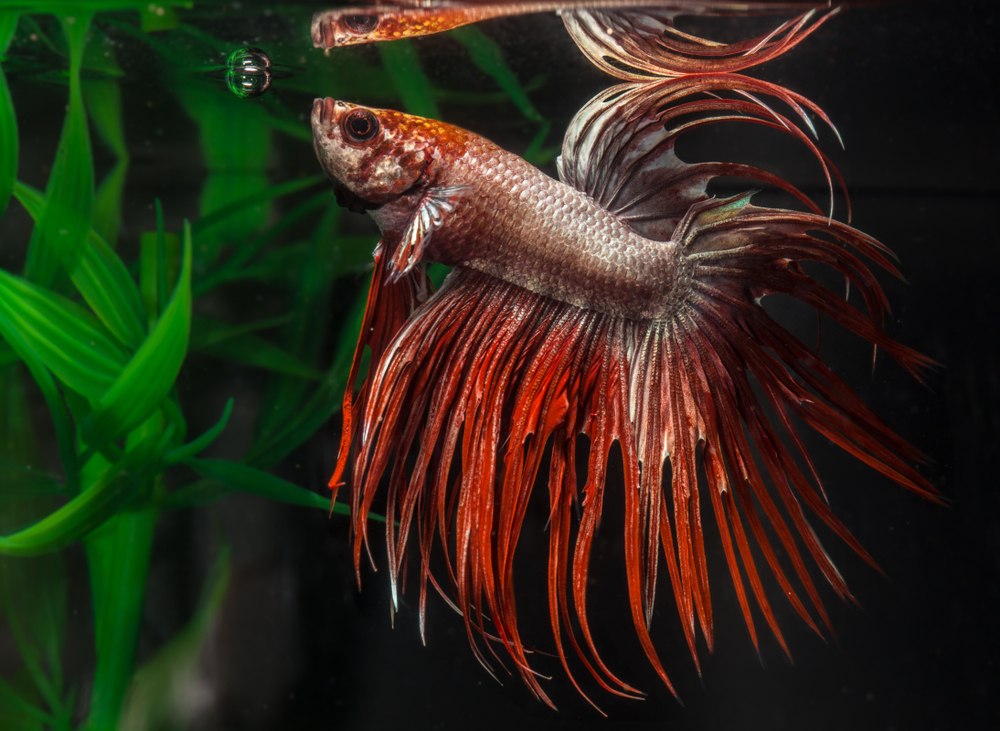
Tiger Barb (Puntigrus tetrazona)
Origin: Southeast Asia
Feeder Type: Mid-Water
Tiger barbs are amongst the liveliest of the commonly kept freshwater fishes. Hailing from Southeast Asia, their common name is a clear description of their physical appearance. They are striped, with vibrant orange fins and exhibit sexual dimorphism. Females are slightly larger than males with a broader shape and a more rotund belly. Males will also develop red/orange noses in the run-up to spawning.
In the wild, tiger barbs will inhabit rivers and swamps that are lined with trees. The decaying plant matter in these areas tends to make the water slightly acidic (pH 6.5), although tiger barbs are generally very hardy fish and can tolerate a range of water conditions. They are avid swimmers and can be very territorial, so they should be kept in a good-sized aquarium of at least 90 litres. A slightly larger tank should combat any overly aggressive behaviour.
Tiger barbs, like many popular fish, have forward-facing lips meaning they are a mid-water feeder. Therefore, they are best suited to sinking, granular foods. They also share a similar diet to most other tropical fish, in that they feed primarily on invertebrates and insect larvae. They can be fed a range of pellets, but the FishScience Tropical Fish Worm Pellets are comprised of bloodworms, earthworms, mealworms and silkworms. This added protein and insect-heavy diet is a great choice as a primary or supplementary feed for these active little fish.
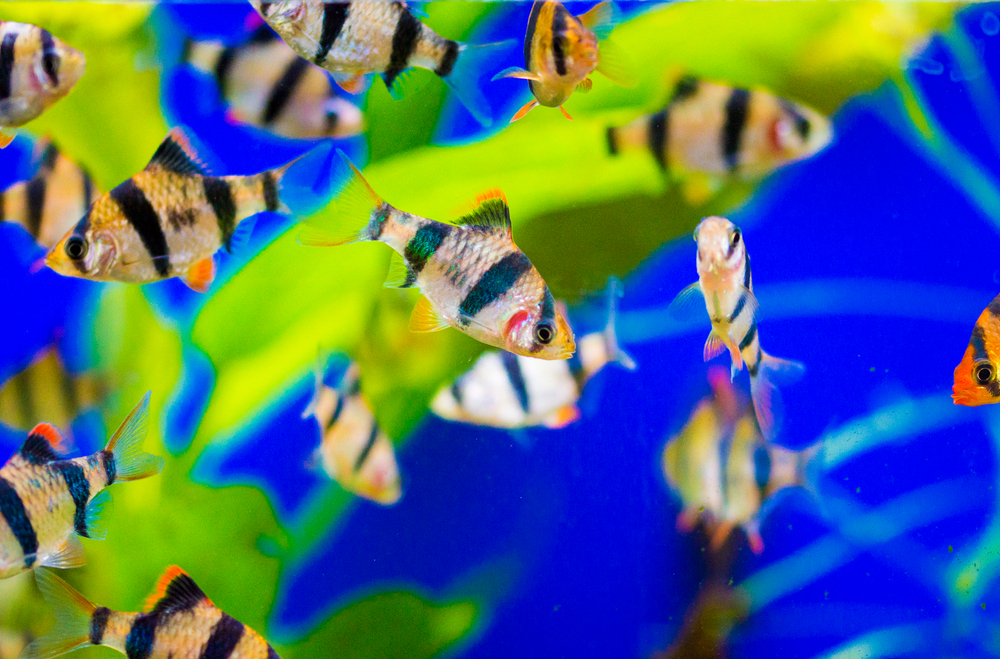
Red-Tailed Shark (Epalzeorhynchos bicolor)
Origin: Southeast Asia
Feeder Type: Mid-Water
Every aquarist, young and old are going to be impressed by a pet shark. Although red-tailed sharks are unlikely to ever appear in a reboot of Jaws, they are boisterous, territorial and adorn that classic torpedo shape associated with the giant ocean predators. Red-tailed sharks are, however, tiny species of carp. They are found in Thailand and providing they are given plenty of room and housed with appropriate species, can be successfully introduced into a large freshwater tank.
Interestingly, the red-tailed shark is considered Critically Endangered and was thought to be extinct in the wild until 2011. Now, only one lake and its connecting rivers in Central Thailand hold the world’s wild population. Even dedicated aquarists believe that the trade in exotic fishes may have spurred this decline. Luckily, these fish are now captive bred in huge numbers and despite the wild waterways under ecological threat, the number of captive red-tailed sharks is very strong.
Red-tailed sharks will bully tank mates if the aquarium is too small. Some hobbyists suggest that pairing these with other boisterous fish such as barbs, will stop any incessant bullying, although some conflict may still occur. It is also important not to house red-tailed sharks with other freshwater ‘sharks’ such as the rainbow shark. This is sure to spark aggression in both individuals and could have disastrous results.
Despite seemingly predatory behaviour, red-tailed sharks are omnivores and thrive on a range of foods including invertebrates, algae and plant matter. They require a granular food that is designed to sink to the mid-water level easily. This is especially important for active, territorial fish such as the red-tailed shark.
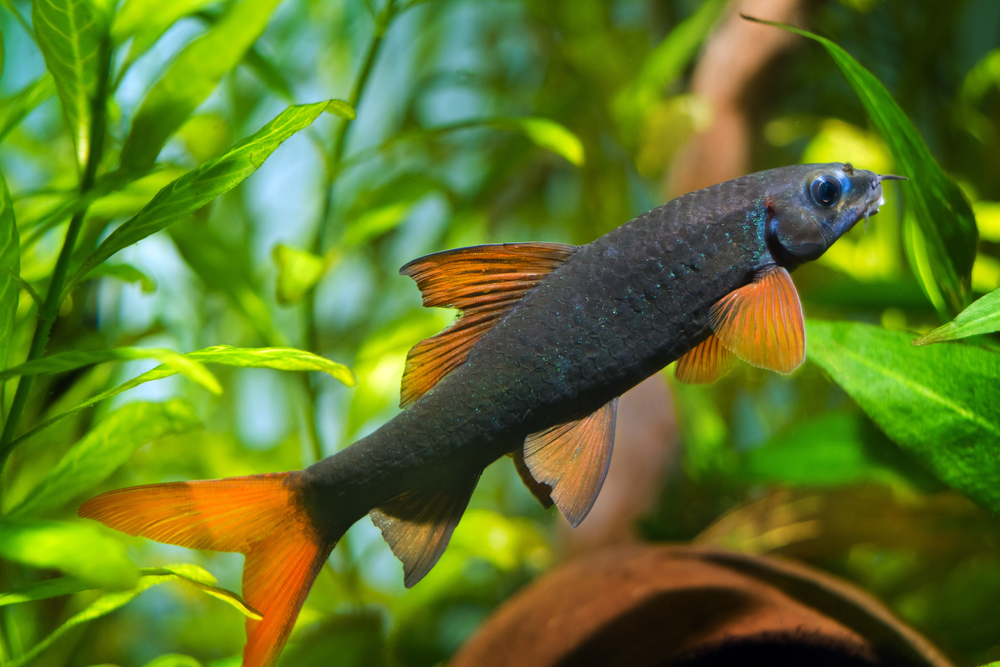
Kuhli Loach (Pangio kuhlii)
Origin: Southeast Asia
Feeder Type: Bottom Feeder
The odd-shaped, Kuhli loach is a small species of Cobitid often mistaken for a colourful eel. They are equally as odd in their behaviour, as they are sociable bottom-feeders that will even burrow into the substrate. Despite being a unique and visually attractive species, kuhli loach are readily available and inexpensive. They have docile temperaments and will assimilate peacefully into a communal tank.
Under the right conditions, Kuhli loach can live up to ten years in captivity. Unfortunately, they are not nearly as hardy as other tropical fish on this list. Their soft skin makes them very susceptible to disease and water parameter changes. Yet, If the keeper can maintain clean water between 23°C and 26°C, with a pH of 5.5 – 6.5 the rest of their care is reasonably straightforward. They are omnivores and will readily accept a whole range of foods, but feed primarily on the riverbed, sifting through rocks for algae. The best way to mimic this is with an appropriately-sized wafer food.
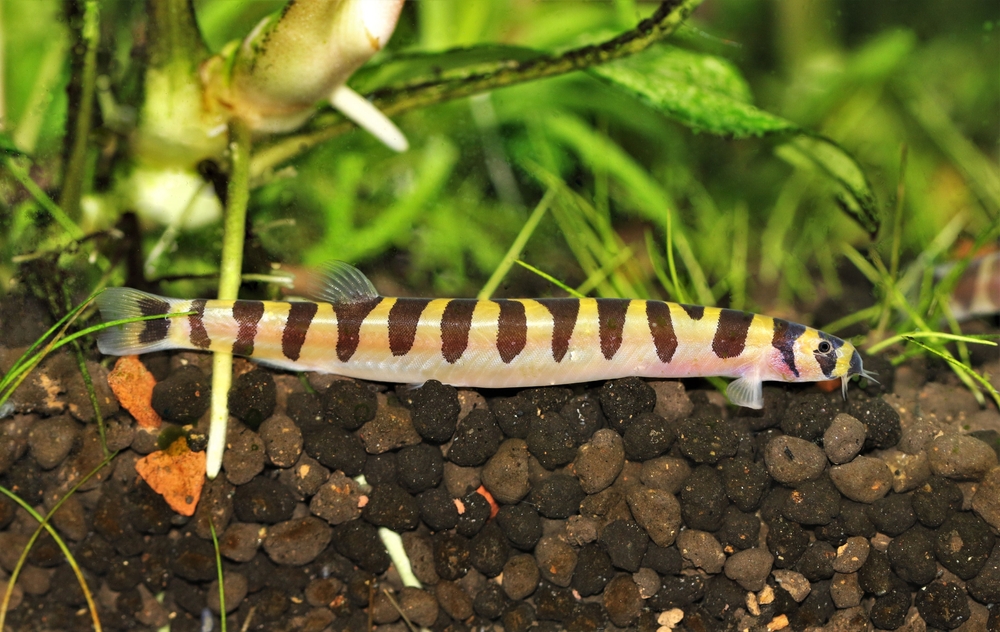
Cichlids
Origin: Rift Valley, Africa
Feeder Type: Mid-Water
Cichlids are an enormous group of fishes that span most of the world’s tropical climates. Many popular fish species are actually types of cichlid, but the archetypal species synonymous with the name, are the Rift Valley Cichlids. These are the fish that are found in the immense lakes of Tanganyika, Malawi, Kivu, Edward and several other bodies of water. There are hundreds of species that inhabit these freshwater lakes and could easily be mistaken for marine fish. Part of their appeal is their bright colouration and therefore, a good quality food is important in keeping them healthy.
As such a diverse group of fish, it is important that keepers research which food suits their fish’s diet best. A food with lots of carotenoid-rich algae will help accentuate the fish’s colour and as some species of Rift Valley Cichlid can grow extremely large, an appropriately-sized pellet or flake is needed. Some of these fishes will also take very large insects from the surface of the water, so providing some additional locust or crickets can lead to some exciting feeding frenzies.

